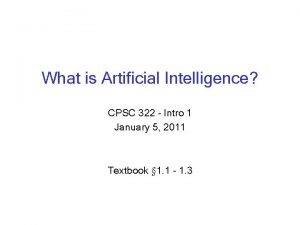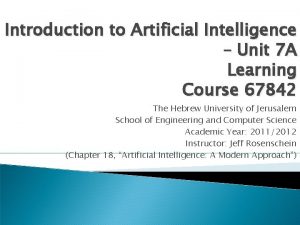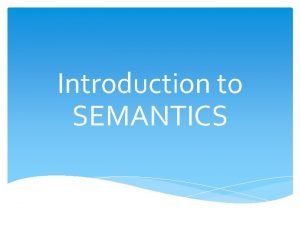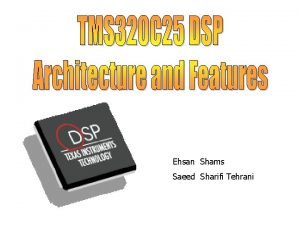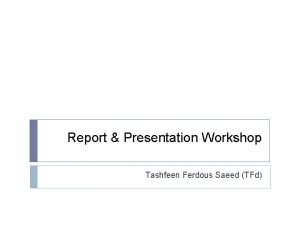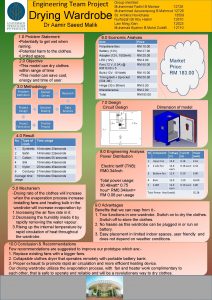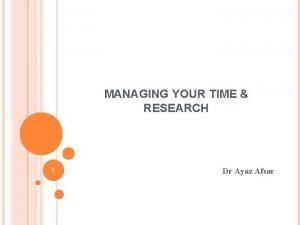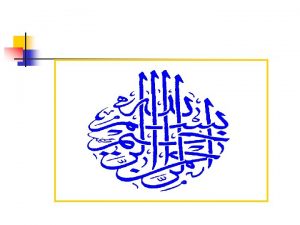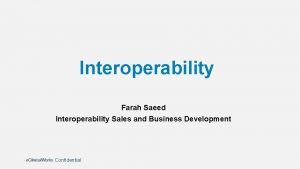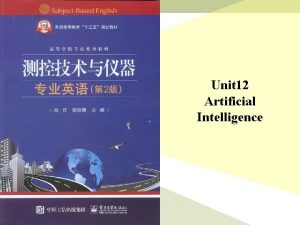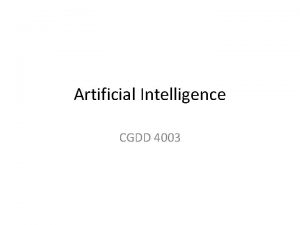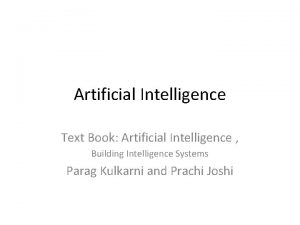INTRODUCTION TO ARTIFICIAL INTELLIGENCE Unit 14 Sumaira Saeed



















- Slides: 19

INTRODUCTION TO ARTIFICIAL INTELLIGENCE Unit 14

Sumaira Saeed Outline • Decision Tree Induction • Decision Tree Rule Extraction • Accuracy and Error Rates Fall 2019 2

Sumaira Saeed Fall 2019 3 Inducing a decision tree • There are many possible trees • How to find the most compact one • that is consistent with the data? • The key to building a decision tree - which attribute to choose in order to branch. • The heuristic is to choose the attribute with the minimum GINI/Entropy.

Sumaira Saeed Fall 2019 4 Algorithm for Decision Tree Induction • Basic algorithm (a greedy algorithm) • Tree is constructed in a top-down recursive manner • At start, all the training examples are at the root • Attributes are categorical • Examples are partitioned recursively based on selected attributes • Test attributes are selected on the basis of a heuristic or statistical measure (e. g. , GINI/Entropy) • Conditions for stopping partitioning • All examples for a given node belong to the same class • There are no remaining attributes for further partitioning – majority voting is employed for classifying the leaf • There are no examples left

Sumaira Saeed Fall 2019 5 Extracting Classification Rules from Trees • Represent the knowledge in the form of IF-THEN rules • One rule is created for each path from the root to a leaf • Each attribute-value pair along a path forms a conjunction. The leaf node holds the class prediction • Rules are easier for humans to understand • Example IF age = “<=30” AND student = “no” THEN buys_computer = “no” IF age = “<=30” AND student = “yes” THEN buys_computer = “yes” IF age = “ 31… 40” THEN buys_computer = “yes” IF age = “>40” AND credit_rating = “excellent” THEN buys_computer = “yes” IF age = “<=30” AND credit_rating = “fair” THEN buys_computer = “no”

Sumaira Saeed Fall 2019 6 Decision Tree Based Classification • Advantages: • Extremely fast at classifying unknown records • Easy to interpret for small-sized trees • Accuracy is comparable to other classification techniques for many simple data sets • One of the nicest things about decision trees is their ability to handle missing values in either numeric or categorical input fields by simply considering null to be a possible value with its own branch.

Sumaira Saeed Fall 2019 7 Cross Validation • Partition: Training-and-testing • Use two independent data sets, e. g. , training set (2/3), test set(1/3) • Used for data set with large number of examples • Stratification: Guarantee that each class is properly represented in both training and testing data sets. • Cross-validation • Divide the data set randomly into k subsamples • The class is represented in approximately the same proportions as in the full dataset • Use k-1 subsamples as training data and one sub-sample as test data—k-fold cross-validation for data set with moderate size

Sumaira Saeed Fall 2019 8 Repeated Cross validations • A single 10 -fold cross-validation might not be enough to get a reliable error estimate. • Different 10 -fold cross-validation experiments with the same learning method and dataset often produce different results, because of the effect of random variation in choosing the folds themselves. • Stratification reduces the variation, but it certainly does not eliminate it entirely. • When seeking an accurate error estimate, it is standard procedure to repeat the cross-validation process 10 times —that is, 10 times 10 -fold cross-validation—and average the results.

Sumaira Saeed 9 Fall 2019 Metrics for Performance Evaluation • Focus on the predictive capability of a model • Rather than how fast it takes to classify or build models, scalability, etc. • Confusion Matrix: PREDICTED CLASS Class=Yes Class=No ACTUAL CLASS Class=Yes a b Class=No c d a: TP (true positive) b: FN (false negative) c: FP (false positive) d: TN (true negative)

Sumaira Saeed 10 Fall 2019 Metrics for Performance Evaluation… PREDICTED CLASS Class=Yes ACTUAL CLASS Class=No Class=Yes a (TP) b (FN) Class=No c (FP) d (TN) • Most widely-used metric:

Sumaira Saeed Fall 2019 11 Limitation of Accuracy • Consider a 2 -class problem • Number of Class 0 examples = 9990 • Number of Class 1 examples = 10 • If model predicts everything to be class 0, accuracy is 9990/10000 = 99. 9 % • Accuracy is misleading because model does not detect any class 1 example

Sumaira Saeed 12 Fall 2019 Cost Matrix PREDICTED CLASS C(i|j) ACTUAL CLASS Class=Yes Class=No Class=Yes C(Yes|Yes) C(No|Yes) Class=No C(Yes|No) C(No|No) C(i|j): Cost of misclassifying class j example as class i

13 Fall 2019 Cost Matrix (Cont’d) PREDICTED CLASS True ACTUAL CLASS False True False 10 5 1 14 PREDICTED CLASS True ACTUAL CLASS False Sumaira Saeed True False 10 6 0 14 PREDICTED CLASS True ACTUAL CLASS False True False 10 3 3 14 All three confusion matrices have the same accuracy value, i. e. , 24 / 30 What if the cost of misclassification is not the same for both type of errors?

14 Fall 2019 Cost Matrix (Cont’d) PREDICTED CLASS True ACTUAL CLASS False True False 10 5 x 5 1 14 PREDICTED CLASS True ACTUAL CLASS False Sumaira Saeed True False 10 6 x 5 0 14 PREDICTED CLASS True ACTUAL CLASS False True False 10 3 x 5 3 14 Suppose the cost of misclassifying True as False is 5 while the cost of misclassifying False as True is 1. Accuracy values are: 24/50, 24/42, 24/54

15 Fall 2019 Cost Matrix (Cont’d) PREDICTED CLASS True ACTUAL CLASS False True False 10 5 x 4 1 14 PREDICTED CLASS True ACTUAL CLASS False Sumaira Saeed True False 10 6 x 4 0 14 PREDICTED CLASS True ACTUAL CLASS False True False 10 3 x 4 3 14 Suppose the cost of misclassifying True as False is 4 while the cost of misclassifying False as True is 1. Accuracy values are: 24/45, 24/39, 24/48

Sumaira Saeed 16 Fall 2019 Cost-Sensitive Measures PREDICTED CLASS ACTUAL CLASS l l l Class=Yes Class=No Class=Yes a (TP) b (FN) Class=No c (FP) d (TN) Precision is biased towards C(Yes|Yes) & C(Yes|No) Recall is biased towards C(Yes|Yes) & C(No|Yes) F-measure is biased towards all except C(No|No)

Sumaira Saeed 17 Fall 2019 Recall and Precision Actual Prediction T T T F F F T T T PREDICTED CLASS Class=Yes ACTUAL CLASS Class=No Class=Yes a (TP) b (FN) Class=No c (FP) d (TN)

Sumaira Saeed Fall 2019 Recall and Precision Actual Prediction T T T F F F T T T • Precision = 4 / 7 18

Sumaira Saeed Fall 2019 Recall and Precision • Recall = 4 / 6 Actual Prediction T T • Precision = 4 / 7 T F • F-Measure = 8 / 13 F T F F F T T T 19
 Introduction to artificial intelligence and expert systems
Introduction to artificial intelligence and expert systems Cpsc 322: introduction to artificial intelligence
Cpsc 322: introduction to artificial intelligence Cpsc 322: introduction to artificial intelligence
Cpsc 322: introduction to artificial intelligence Unit 7 artificial intelligence
Unit 7 artificial intelligence Alnami
Alnami Contradiction in semantics
Contradiction in semantics Dsp
Dsp Saeed khan wayne state
Saeed khan wayne state Tashfeen saeed
Tashfeen saeed Dr aamir saeed
Dr aamir saeed Dr ayaz saeed
Dr ayaz saeed Dr.saeed ahmed
Dr.saeed ahmed Dr ayaz saeed
Dr ayaz saeed Dr farah saeed
Dr farah saeed Saad azhar saeed ucp
Saad azhar saeed ucp Architecture of expert system
Architecture of expert system Prolog iterative deepening search
Prolog iterative deepening search Searching for solutions in artificial intelligence
Searching for solutions in artificial intelligence 15-780 graduate artificial intelligence
15-780 graduate artificial intelligence Knowledge manipulation in ai
Knowledge manipulation in ai

